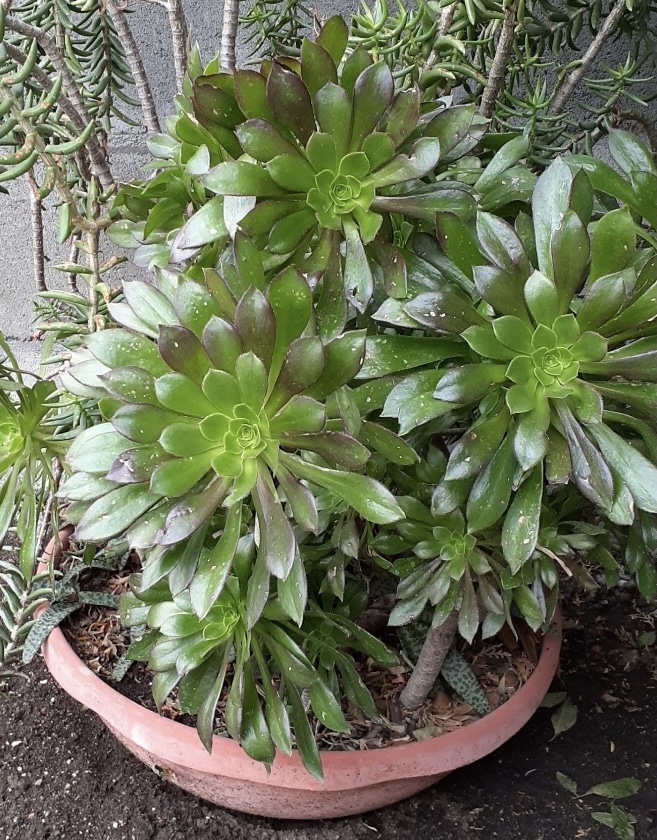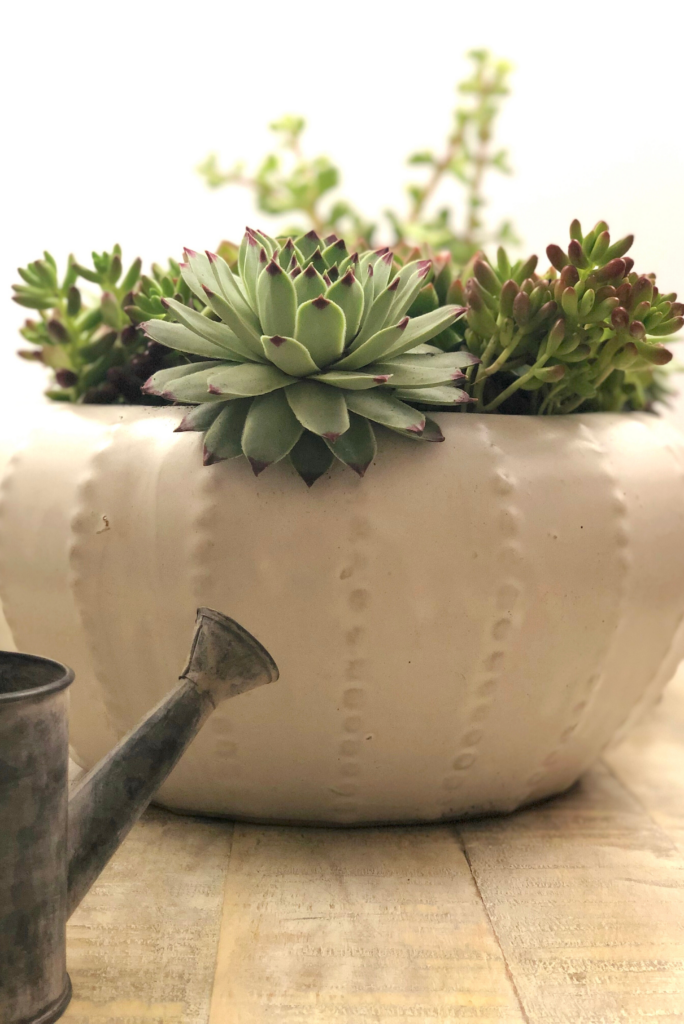Why Do Succulents Turn Red? Top Reasons They Change Colors
Have you ever wondered why succulents change color? Or why your succulents are turning red? If you have, you’ve probably noticed how beautiful they look when they change colors.
Maybe you’re an admirer of succulent plants that are pink, red, purple, and even ombre? If so, I don’t blame you; I love them too!
In this post, I’ll talk about the many reasons your succulent is turning red or changing hues and how to help them do so if that’s your goal.

When I first learned that succulents can actually change their tones, I was amazed. I figured they stayed the same shade their whole life.
But I was wrong. And it only makes succulents more fascinating.
The truth is, when succulents change tones, it’s actually due to stress from environmental changes.
The only way they don’t change is if their environment never changes, and I think we all know that’s impossible. Plants regularly experience extreme environmental conditions, cold temperatures, and changes in watering frequency.
Even with proper care, your succulents are bound to experience several types of stress. The good thing is, a change in color is not an indication that your succulent is in trouble.
And while many succulent varieties don’t take on different shades, many popular ones do. And some only experience a change in color along the rim of their leaves, and not the entire plant.
Today, I’m going to teach you exactly WHY succulents change color and how you can help them do so if that’s your wish.
Let’s get to it!

Succulents Change Color When Stressed
It’s hard to believe that a colorful succulent that looks healthy is actually stressed, but it’s true.
In fact, changing color is their reaction to sudden changes in watering, sunlight, or temperature.
If you had a succulent that was once green and now it morphed into a different color, then that succulent is most likely existing in a state of stress.
Don’t worry, though! Most of the time, this type of stress isn’t enough to harm your plant.
There are 3 main factors that can cause succulents to change color and those include:
-lack of water
-too little or too much direct sunlight that happened suddenly
-very high temperatures (extreme heat) or lower temperatures
We’ll talk about them in the sections below.

How Sunlight Causes Succulents to Change Color
In my experience here in Southern California, my succulents tend to change color as a result of more (or less) exposure to direct sunlight. Direct sun helps to bring out different colors in plants.
Reduced sunlight, on the other hand, causes a once-colorful succulent to revert back to a dark-green shade. This loss of color can lead people to believe they did something wrong when in fact they didn’t!
If you’ve ever purchased a colorful succulent from the garden center and noticed that it started to lose its color, you likely placed it in a spot that gets far less sunlight than it was accustomed to at the garden nursery.
You most likely gave your succulent too much shade!

Always keep in mind that environmental factors play a big role in whether some plants have red pigment. Put simply, what your succulent looks like has a lot to do with how much sunlight you give it.
A healthy plant requires bright light in order to keep its vibrant colors and the right colors are usually an indication that your plant is getting enough sunlight.
If, for instance, you’ve noticed your jade plant turning red, don’t panic. Your plant isn’t going to wither away, it’s just experiencing “good stress” from more exposure to sunlight.
This is a common occurrence when growing succulents indoors and then moving them outdoors. It’s pretty difficult to maintain colorful succulents when they’re indoors, which is why you see more dark green succulents inside the home.

Think jade plants, snake plants, aloe vera and Haworthia Zebra.
The three images below are of the same variety: Aeonium Black Rose. The dark purple version has spent its life in full sun while the green plants have been shaded by taller plants and trees.



Many succulents like jade plants (Crassula) will be more of a dark green shade if grown in full or part shade.
Give them a few days in direct sun, however, and they’ll start to lighten and form a red or pink lining along the rim of their leaves – it’s remarkable! See the photo below for proof.
This change in color has to do with science: succulents are able to produce carotenoids and anthocyanin to deal with sudden and longer exposure to sunlight.
Carotenoids will produce an orange, yellow or reddish color while anthocyanin will produce a more purple or blue hue.
This is the plant’s way of protecting itself, similar to the way we humans protect ourselves from the sun’s rays.
Fortunately for those of us who love colorful succulents, their reaction to more sunlight results in quite a colorful show!

Succulents Change Color After Temperature Fluctuations
Yes, temperature definitely affects your succulents.
Some succulents can handle extreme temperatures and full sun, but this doesn’t mean that sudden temperature fluctuations don’t stress them out.
As the seasons change, your succulents react to the drop or rise in temperature by changing colors. It’s their way of self-preserving.
It’s the most common reason for red leaves and color changes.
And with a significant drop or increase in temperature comes a change in sunlight exposure, too. Temperature and sunlight usually go hand-in-hand -which is double the stress for them!
This is why you’ll notice that your succulents are more colorful in the spring and summer when the temperatures rise and there are more sunlight hours a day.
This is very evident in jade plants (crassula ovata).
Your jade plant’s leaves will likely feature red tips the more sunlight it gets and the more heat it experiences. It makes for a beautiful show. Some jade plant leaves turn orange, and some turn pink.
The tips of the leaves are healthy but they’re also showing you that they’re adjusting to higher temperatures and direct sunlight.
As the seasons change, you might notice some of your succulents revert back to green.
*If you live in an area that experiences winters that drop below 30 or 20 degrees, then you’ll have to move your succulents indoors (unless you grow cold-hardy succulents, like Sempervivum Hens and Chicks).
Such low temperatures are considered bad stress for most succulents and they simply won’t survive it.
Cold winter months that might start in late autumn for many parts of the country mean it’s time to bring your plants indoors until the threat of frost has passed.

How Watering Causes Succulents to Change Color
I want to preface this by saying that improperly watering your succulents is the fastest way to kill them!
Over-watering and under-watering can cause serious harm to your plants and this is what people struggle with the most when it comes to succulent care.
With that being said, it’s important to note that well-watered succulents are more prone to being green because they’re not stressed out.
Sometimes, holding back on watering for an extended period of time can stress out your plant so much that it will change color.
As stated above, succulents change color when they’re under duress so making huge changes to your watering schedule can be tricky if you take it too far; you don’t want to dehydrate your plants to the point of no return.
While you never want to deprive your succulents of water for very long periods of time (especially in the summer, this is a big no-no) holding back a little will stress them out and thus cause them to change their hue to something other than green.
It might sound reckless, but many people purposefully skip one or two waterings for this very reason.
I usually water my outdoor succulents once a week (or three times a week or more during heatwaves), so if I wanted to test this out, I would try watering every 2 weeks to see if there’s any change in color.
However, I would never do this here during the summer months because most days are over 90 degrees and we get many triple-digit days, too.
Root systems need moisture in order to deal with the heat, and this is especially important for succulents that are in full sun.
If you go this route, test things slowly and don’t make extreme changes as you don’t want to cause irreversible damage.
For a refresher on how to water succulents properly, this watering post is great for both indoor and outdoor succulents.

How to Make Succulents Change Colors
At this point, you’re probably wondering about how to make succulents change color.
I don’t blame you since colorful succulents are so beautiful. Green succulents definitely have their place, though, and many of them liven up indoor spaces with their deep-green shades.
Take Snake Plants (certain varieties) and Haworthias for instance; they stay different shades of green no matter their environment or watering schedule.
But other succulents, like Jade plants, Echeverias, and Graptosedum rosettes, do in fact adjust their tones when they experience changes in light, temperature, and watering.
I think the easiest way to help your succulents change color is by moving them into direct sunlight. It’s as simple as that.
Moving them out of the shade and into full, direct sun is a big enough change to cause a reaction.
This change is easy to achieve during mid-spring and early summer when the temperatures start to rise and the days become longer with more hours of sunlight.
This Euphorbia Fire Stick cactus below is usually green during the colder months and red during the hotter months when it gets stronger sunlight.
Don’t forget to acclmate your succulents, first, though, when exposing them to temperature changes. Keep in mind that moving a succulent from full shade to full sun on a day that’s above 90 degrees may lead to severe sunburn; sunburn is one of the worst things that can go wrong with your succulents.
If you’re doing this during the summer, then I recommend doing it slowly over a period of several days. Don’t just leave your succulents out in the hot sun without acclimating them to more light, first.

Hopefully, by now, you have a good understanding of why your succulents changed color, why they lost color, or why they reverted back to deep green.
While not all of your succulents are able to turn red, pink, orange, yellow, or purple, many do and it’s always fun to notice those!
I’ll leave you with one last tip: if you brought a colorful succulent home from the garden nursery, try keeping it in direct sun because that’s probably what it’s used to.
You can also ask the nursery what they recommend.
Good luck!
Related Posts about Succulents: